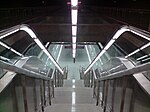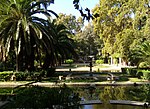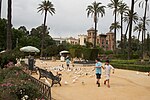Seville Fair

The Seville Fair (officially and in Spanish: Feria de Abril de Sevilla, "Seville April Fair") is held in the Andalusian capital of Seville, Spain. The fair generally begins two weeks after the Semana Santa, or Easter Holy Week. The fair officially begins at midnight on Saturday, and runs seven days, ending on the following Saturday. Each day the fiesta begins with the parade of carriages and riders, at midday, carrying Seville's leading citizens which make their way to the bullring, La Real Maestranza, where the bullfighters and breeders meet. For the duration of the fair, the fairgrounds and a vast area on the far bank of the Guadalquivir River are totally covered in rows of casetas (individual decorated marquee tents which are temporarily built on the fairground). These casetas usually belong to prominent families of Seville, groups of friends, clubs, trade associations and political parties. From around nine at night until six or seven the following morning, at first in the streets and later only within each caseta, there are crowds partying and dancing sevillanas, drinking Sherry, manzanilla or rebujito, and eating tapas. This fair also has an amusement park that comes with it and has many games to play along with roller coasters to ride.
Excerpt from the Wikipedia article Seville Fair (License: CC BY-SA 3.0, Authors, Images).Seville Fair
Avenida Flota de Indias, Seville Los Remedios
Geographical coordinates (GPS) Address Nearby Places Show on map
Geographical coordinates (GPS)
| Latitude | Longitude |
|---|---|
| N 37.371111111111 ° | E -5.9975 ° |
Address
Real de la Feria de Abril
Avenida Flota de Indias
41011 Seville, Los Remedios
Andalusia, Spain
Open on Google Maps











